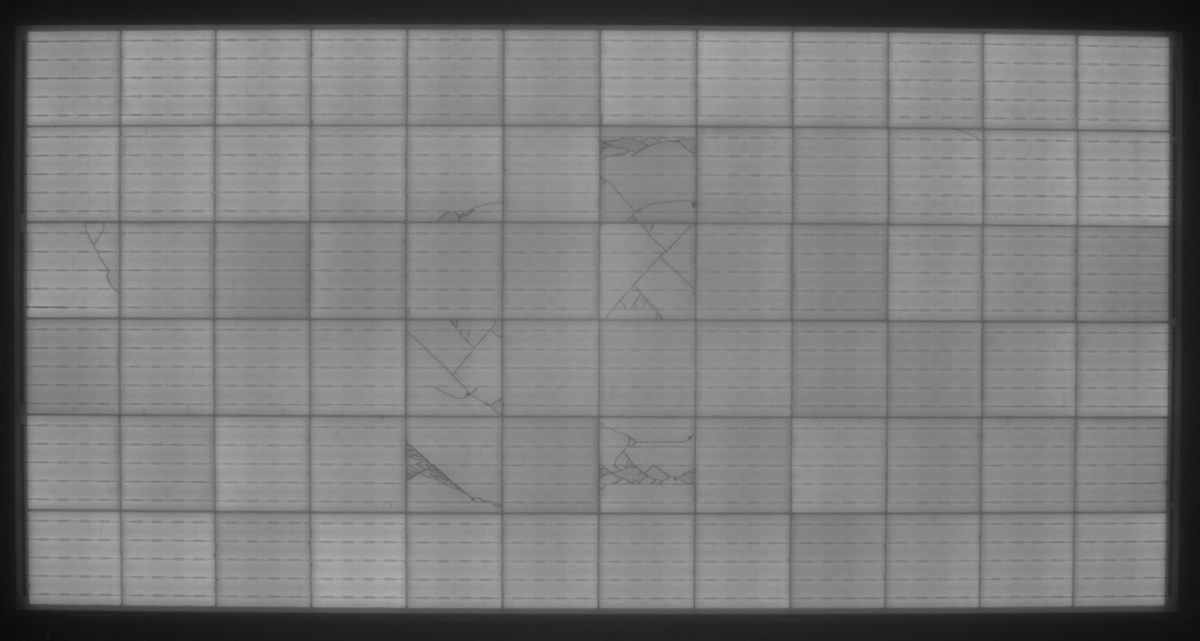From pv magazine global
Cell cracking has emerged in recent years as a threat to module performance in the field. In certain projects, cracks have been shown to cause as much as 9% performance loss – more than enough to hurt profitability.
Cracking is the result of excessive thermal or mechanical stress being placed on a module, and can occur during manufacturing, transport, handling and even after deployment. The fact that cracks often start out too small for most testing to detect, and grow over time to reduce module performance, complicates the picture even further.
Module reliability experts PV Evolution Labs (PVEL) put more than 40 modules representing the bulk of commercially available technologies through rigorous stress testing, to better understand the likelihood of cracks occurring and affecting performance in the field.
Some of their observations from this testing are published in a new white paper. The paper concludes that each module will behave differently, and testing a specific bill of materials (BOM) is the only way to be sure of its susceptibility. However, PVEL’s testing also draws reveals some interesting trends in terms of new technologies and the risk of cracking.
Strong performers
The white paper finds that certain recent technology trends serve to reduce the risk associated with cracking – monocrystalline cells, now representing more than 80% of the market, are less susceptible, and recently introduced multibusbar interconnection reduces the chance of a crack creating an inactive area on the module.
Interdigitated back contact modules, glass-glass and thin film technologies all showed little to no cracking after going through PVEL’s mechanical stress testing. Half-cut cell technology is also shown to reduce the risk of cracking by more evenly distributing pressure over smaller surfaces, provided the formation of microcracks is avoided in cell cutting.
New risks
Another trend revealed in the testing is that larger module surface areas tend to equal more cracks – a highly relevant finding given the switch to larger formats that continues to play out in module manufacturing.
PVEL warns that larger surface areas, both in wafer and module, can mean more deflection during high loads, and more risk of cracking. High density interconnection techniques, reducing the gap between cells, could also increase the amount of mechanical stress placed on individual cells. The white paper offers an example where two modules of 120 and 144 cells, otherwise with the same BOM, were tested, and the 144 cell version showed significantly more cracking.
They also note that storms, changes in temperature and other weather conditions can cause cracking in the field, and the increased frequency of extreme weather events in many regions presents further of risk of cracking, alongside other damage to modules in the field.
“Crack susceptibility is nuanced,“ the PVEL experts conclude. “Several new technologies are inherently less susceptible to cracking, but some older technologies may perform better than their newer counterparts. Crack susceptibility ultimately depends on the specific components and manufacturing techniques employed in PV module production.” And the lab plans to continue testing, with close to 100 new BOM’s lined up for next year.
This content is protected by copyright and may not be reused. If you want to cooperate with us and would like to reuse some of our content, please contact: editors@pv-magazine.com.









By submitting this form you agree to pv magazine using your data for the purposes of publishing your comment.
Your personal data will only be disclosed or otherwise transmitted to third parties for the purposes of spam filtering or if this is necessary for technical maintenance of the website. Any other transfer to third parties will not take place unless this is justified on the basis of applicable data protection regulations or if pv magazine is legally obliged to do so.
You may revoke this consent at any time with effect for the future, in which case your personal data will be deleted immediately. Otherwise, your data will be deleted if pv magazine has processed your request or the purpose of data storage is fulfilled.
Further information on data privacy can be found in our Data Protection Policy.